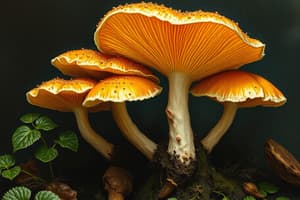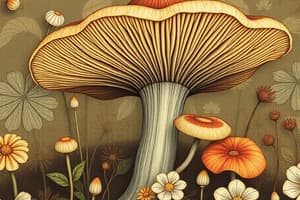Podcast
Questions and Answers
What type of reproductive structures are formed by Zygomycota during sexual reproduction?
What type of reproductive structures are formed by Zygomycota during sexual reproduction?
- Asci
- Zygospores (correct)
- Basidia
- Conidia
Which group of fungi is primarily associated with arbuscular mycorrhizal relationships with plant roots?
Which group of fungi is primarily associated with arbuscular mycorrhizal relationships with plant roots?
- Zygomycota
- Glomeromycota (correct)
- Deuteromycota
- Chytridiomycota
Which of the following fungi is known for producing the antibiotic penicillin?
Which of the following fungi is known for producing the antibiotic penicillin?
- Saccharomyces cerevisiae
- Rhizopus stolonifer
- Batrachytium dendrobatidis
- Asergillus (correct)
What type of spores are produced by Deuteromycota?
What type of spores are produced by Deuteromycota?
Which of the following best describes the life cycle of Basidiomycota?
Which of the following best describes the life cycle of Basidiomycota?
Flashcards are hidden until you start studying
Study Notes
Chytridiomycota
- Mostly aquatic fungi with flagellated spores called zoospores
- Exhibit both sexual and asexual reproduction
- Examples:
- Allomyces - a water mold chytrid
- Batrachytium dendrobatidis - causes chytridiomycosis in amphibians
Zygomycota
- Form zygospores, which are reproductive structures capable of surviving harsh conditions
- Zygospores form during sexual reproduction
- Terrestrial fungi that depend on decaying material
- Have coenocytic hyphae (multinucleated)
- Examples:
- Rhizopus stolonifer - black bread mold
- Pilobolus - grows on dung
Glomeromycota
- Form arbuscular mycorrhizal associations with plant roots for nutrient exchange, a mutualistic relationship
- Reproduction through multinucleated spores
- Example: Glomus
Ascomycota (Sac Fungi)
- Form asci, sac-like structures containing sexual spores (ascospores)
- Also produce asexual spores called conidia
- Examples:
- Saccharomyces cerevisiae - baker's yeast
- Penicillium - produce antibiotics
- Aspergillus - used in fermentation, some are pathogenic
Basidiomycota (Club Fungi)
- Form basidia, club-shaped structures that contain spores
- Typically have complex life cycles with both asexual and sexual stages
- Examples:
- Agaricus bisporus - edible mushrooms
- Ustilago maydis - corn smut
- Ganoderma lucidum - used in traditional medicine
Deuteromycota (Fungi Imperfecti)
- Lack a known sexual reproduction phase (anamorphic fungi)
- Reproduce asexually through conidia
- Examples:
- Candida albicans
- Aspergillus niger - produces citric acid
Lichens
- Symbiotic association between fungi (usually Ascomycota) and photosynthetic organisms (algae)
- Used as bioindicators
Studying That Suits You
Use AI to generate personalized quizzes and flashcards to suit your learning preferences.




